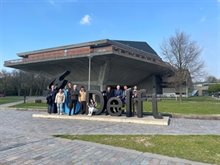ACT-CEMENTEGRITY Final Report
Download the ACT-CEMENTEGRITY Final Report
From 2021-2024 Delft University of Technology was involved in the international ACT project “CEMENTEGRITY”, in the Netherlands aided by EBN as company partner. CEMENTEGRITY performed research into the main mechanisms by which leakage might form through or along a wellbore seal in a CCS-reservoir, with the aim of identifying the critical properties of a cured cementitious sealant for ensuring long-term seal integrity. We studied five different sealant compositions, based on three different binder technologies and with different TRL’s and identified three key abilities. These are (1) the ability to form and maintain a seal against other materials; (2) the ability to resist exposure to chemical stressors (i.e., CO2-containing fluids); and (3) the ability to withstand physical impacts (esp. thermal shock or cycling). Furthermore, the material must maintain each of these abilities when even exposed to any deleterious effects related to CCS. None of the five blends showed superior performance on all aspects tested. Based on this outcome, the best performance may be achieved by selecting individual blends for different parts of the wellbore system, tailoring the required performance based on the expected local conditions. Furthermore, the learnings from the CEMENTEGRITY project can lead to better all-round blends. For details on all tests performed, please see the final report.
As to work done in the Netherlands specifically, TU Delft hosted two scientific workpackages, WP3 and WP4. In WP3, Dr. A. Pluymakers and dr. K. Li have designed and executed novel experiments to determine the impact of thermal shocks on five different types of wellbore sealants. This included the thermo-mechanical effect on the potential for the development of a leaking micro-annulus between wellbore sealant and steel pipe, as well as bulk sealant properties. In WP4, led by prof. G. Ye, dr. X. Qiu and dr. M. Gupta developed a numerical mechano-chemical model for cement proofing and CO2 reaction for a specific, novel sealant design based on geopolymer.
The CEMENTEGRITY project was funded through the ACT programme (Accelerating CCS Technologies, Horizon2020 Project No 691712). Financial contributions from the Research Council of Norway (RCN), the Netherlands Enterprise Agency (RVO), the Department for Energy Security & Net Zero (DESNZ, UK), and Harbour Energy are gratefully acknowledged. For more information on the project, please see Home | ACT CEMENTEGRITY
